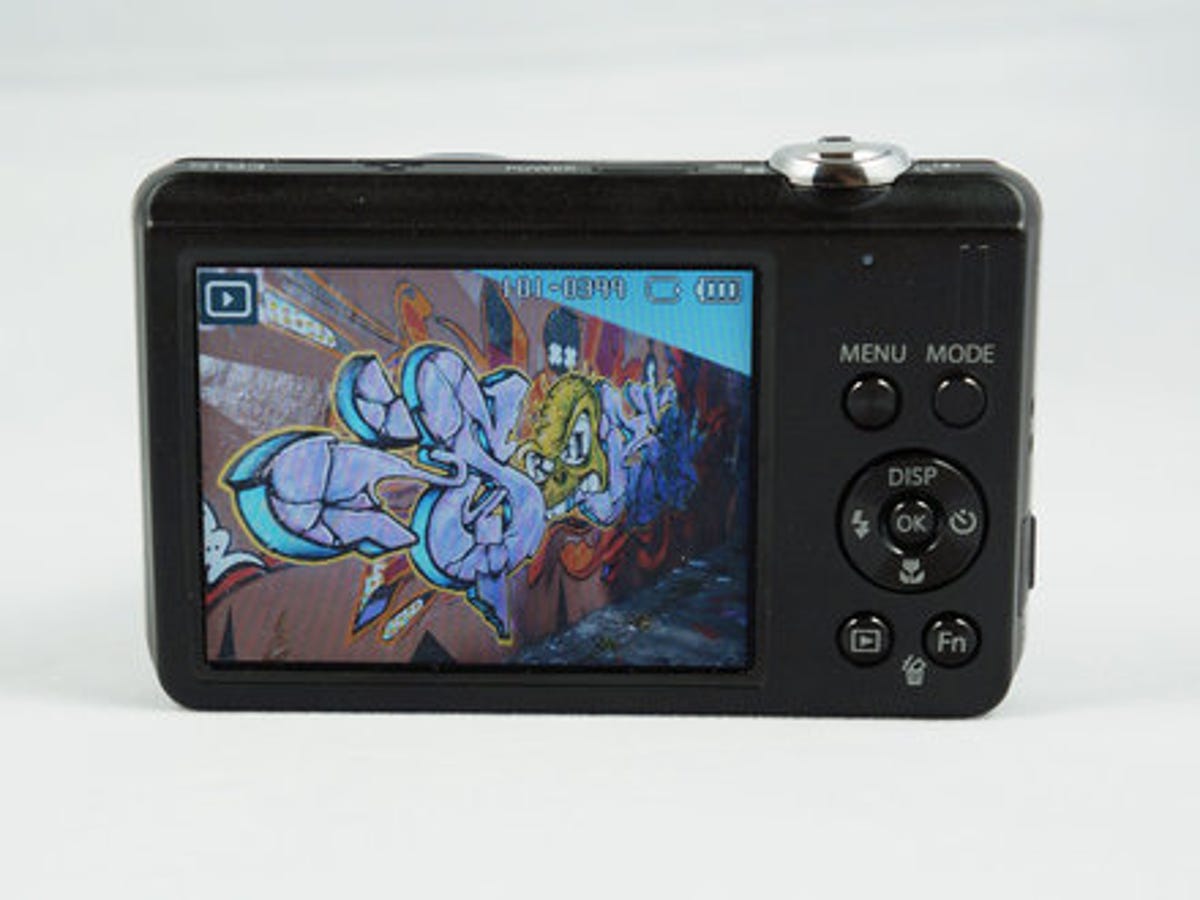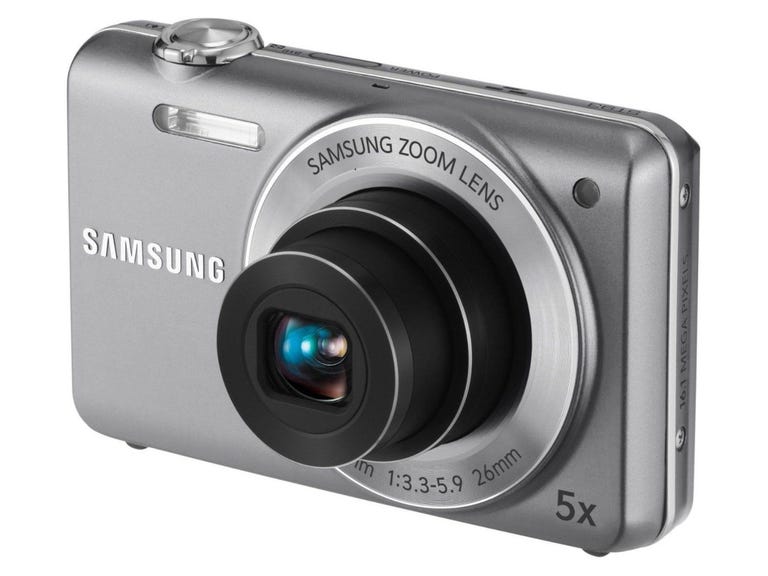 Why You Can Trust CNET
Why You Can Trust CNET Samsung ST93 review: Samsung ST93
The Samsung ST93 is a small and good-looking camera that is ideal for snapping away but its quality is not as good as its rivals.
The Samsung ST93 looks lovely. It doesn't quite rival the Canon Ixus 230HS, but it comes close, with a small body and neatly rounded corners. The Ixus 230HS set a very high bar, earning itself a five-star rating for its sharp images, great colours and excellent level of detail. The ST93 didn't match it on that front, but at less than half the price it deserves a closer look.
The Good
The Bad
The Bottom Line
Samsung's Shrunken Shooter
One way in which Samsung has kept things on a Lilliputian scale is through its choice of memory format. It's opted for microSD, which is just 1mm thick and 15 x11mm face on. That's less than half the size of regular SD in every direction, and around a quarter of the weight of the average SD card. Fortunately there's very little difference in price with this format, and the cards are often sold with an adaptor to make themcompatible with regular card readers.

The buttons are small but perfectly useable, and the menu is stripped down to the essentials, which makes it easy to find your way around without frequent reference to the manual.
Performance
So, that's all good -- and so is the super-quiet zoom, which lets you frame your shot without turning heads. It's also very quick to fix its focus, so you shouldn't miss a spontaneous shot.
Smart Auto mode does an excellent job of picking the most appropriate settings for whatever you're currently framing, displaying the current aperture setting in the corner of the screen and automatically selecting macro when required.
Battery life it particularly impressive; after three days of shooting the gauge still showed two thirds of its power remaining. In other respects, though, the ST93 left us disappointed.
To get the best results you really need well-lit surroundings. It had a tendency to demand the flash in what we would consider fairly bright situations where the flash would have little effect anyway because the framing encompassed so large an area. When we manually suppressed it, the ST93 responded by dialling up its sensitivity, as we would expect, but with a corresponding impact on the quality of the picture.
The image below was shot in a marketplace with a glass ceiling that lets light in. It was shot in the middle of the afternoon on a sunny day. In fully automatic mode the ST93 increased its sensitivity to ISO 400, which impacted on the level of detail captured in the more intricate parts of the image. This is most noticeable in the grid to which the ducks are tied, where fine detail is lost in the upper quarter of the frame. For comparison, we have included a detail section of the same image as taken by the Canon PowerShot SX150 IS, outlined in red. The Canon hiked its sensitivity still further -- to ISO 640 -- yet as can be seen it retained sharper detail in this area, most likely because of the lower pixel count on its sensor (14mp).
In this shot of a flower stall, sensitivity was pinned at a more conservative ISO 240 and the shutter speed was increased from 1/15 to 1/30 second, but as can be seen from the results this is still too slow for handheld shooting.
This may limit the ST93's appeal in some situations. When presented with a scene that is both broad and deep, you can't rely on the flash to provide adequate illumination, whatever camera you're using. Neither can you use a tripod in a busy street or market. You therefore need a shooter that can capture sufficient light with a relatively short exposure to minimise shake, without increasing sensitivity to a level that introduces too much noise into the picture. On this front, the ST93 fares poorly.
In situations where the level of light made it possible to both minimise the sensitivity setting and increase the shutter speed to a level suitable for hand-held operation, the results were much improved. This picture of St Paul's Cathedral reflected in a chrome ball demonstrates good, sharp edges to the ball and an excellent dynamic range with good, even colour levels across the full spectrum.
In this picture of an apple stall, the fruit is very well rendered, and there's great differentiation in the subtle red and green shifts as you move from crate to crate. Sensitivity has been kept down to ISO 80, but the shutter speed remains a fairly slow 1/60 second, which will still be too slow for some users to keep steady when shooting by hand.
Our interior still life test threw up some mixed results. Under studio lighting the ST93 performed very well, dropping its sensitivity to ISO 80 and the shutter speed to 1/60, which helped keep noise to a minimum (we were using a tripod on this occasion). When we switched to ambient lighting it naturally had to increase the sensitivity to ISO 640 and slowed the shutter speed yet further to 1/20 second, at which point there was a noticeably increased level of noise in the image. It found a happy medium when we forced the flash, producing a sharp, well exposed result, full of crisp detail and realistic colours.
Creative credentials
There's an impressive range of firmware helpers for the less confident shooter, with some smart scene modes that go beyond the regular sunset, snow and landscape options (which are also present).
Object highlight, for example, takes two shots and combines them to give your subject a blurred background; beauty shot smooths your subject's skin; and magic frame drops them into a graphic overlay. Some of these are great, putting your subject onto the cover of a magazine or inside a TV screen.
There's a sweep-to-shoot panorama feature, too, which detects the direction in which you're moving and stitches together the scene in real time.
Movie mode
Here, the ST93 performed fairly well. It responded extremely well to changing light levels and even when we shot directly towards the sun it managed to properly capture the rest of the frame, keeping colours true without dialling down the exposure.
The zoom is quiet in general use, as we stated above, but if you're a belts-and-braces shooter who would rather take no chances then you'll want to switch on the Sound Alive feature, which dips the soundtrack recording volume as you move the lens in and out. On the one hand this is a good thing -- nobody wants to hear the whirring of motors on the film of a best friend's wedding -- but on the other it isn't ideal (we want to hear the vows, after all). It's effective, doing exactly what it promised and keeping our movie free from the sound of any mechanics.
Conclusion
The ST93 has much going for it. Battery, size and firmware features all earn it some serious ticks. Where it really matters, though -- the quality of its pictures -- it's more difficult to recommend. Those 16 megapixels sure sound appealing, but in reality it's too many for the sensor to handle. This is a shame, as Samsung has an excellent pedigree when it comes to producing top-notch cameras. Check out the company's WB700, which earned itself four stars and high praise in our review. It may be another two-thirds more expensive than this example, but if you can afford it, then it would be money very well spent.


